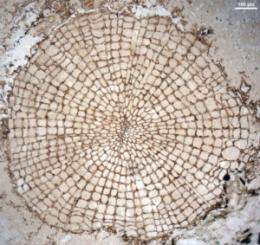August 12, 2011 report
Scientists identify oldest wood specimens

(PhysOrg.com) -- Researchers studying two fossilized plants, one from New Brunswick, Canada, the other from France have been identified as being 397 and 407 million years old respectively. Both are believed to be the oldest known examples of wood, predating previously found specimens by ten million years. Lead researcher Philippe Gerrienne, of Belgium, and his team have published the results of their research in Science.
The New Brunswick sample was found by co-author Patricia Gensel, who brought it back to the University of North Carolina where she is a professor of paleobotany. The fossil remained on the shelf apparently for several years before it was included in a study being led by Gerrienne, (research associate and lecturer at the University of Liege) of the plant specimen found in France.
The two specimens are believed to be not just the earliest examples of wood found, but actual samples of wood in its earliest form of existence. Both plants were very small, just 20 centimeters tall (with stems just 12 centimeters tall and 3 to 5 centimeters wide) and were a type of herb.
After studying cross sections of the plants, the researchers have theorized that wood did not evolve as a means to allow plants to grow taller as has been widely assumed, but to allow for the more efficient transfer of water and nutrients from the soil to the rest of the plant. They say they believe this is so because of the way that cells are arranged in the cores of the stems, and even more so because of the existence of long thin cells that grow across several rings, extending like rays from the middle to outer edges of the stems; both are reminiscent of modern trees. The presence of thick walled cells adds to the evidence. Because these structures were in place in very small plants, it’s hard to argue that they evolved to allow for more height.
The authors suggest that because these plants were living in a time (the early Devonian age - 407 to 397 million years ago) when the amount of carbon dioxide in the air was decreasing (which reduced water-use efficiency) they were forced into coming up with something quick to survive; hence, the development of wood.
The plants discovered are believed to be the ancestors of modern trees, the wood that evolved to help in nourishment wound up having the side benefit of allowing the trees to grow into the comparatively mammoth specimens found around the planet today.
More information: A Simple Type of Wood in Two Early Devonian Plants, Science 12 August 2011: Vol. 333 no. 6044 p. 837. DOI:10.1126/science.1208882
ABSTRACT
The advent of wood (secondary xylem) is a major event of the Paleozoic Era, facilitating the evolution of large perennial plants. The first steps of wood evolution are unknown. We describe two small Early Devonian (407 to 397 million years ago) plants with secondary xylem including simple rays. Their wood currently represents the earliest evidence of secondary growth in plants. The small size of the plants and the presence of thick-walled cortical cells confirm that wood early evolution was driven by hydraulic constraints rather than by the necessity of mechanical support for increasing height. The plants described here are most probably precursors of lignophytes.
© 2011 PhysOrg.com
















